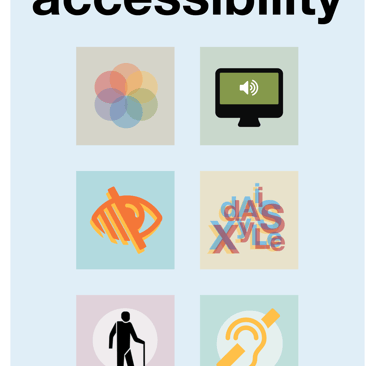Accessibility & Privacy Mini Module
Click the poster to learn more about accessibility best practices
UKHomeOffice. (2019). Accessibility posters set. https://github.com/UKHomeOffice/posters/blob/master/accessibility/dos-donts/posters_en-UK/accessibility-posters-set.pdf
Click the graphic to learn more about legal frameworks in instructional design
Accessibility Module FAQs
What is this course?
It's a module focused on internet accessibility basics.
How many quiz questions?
There are 20 questions designed to test your understanding.
Who should take this course?
Anyone interested in making the web more accessible will benefit.
Is prior knowledge needed?
No, the course starts with the basics for all learners.
How long is the module?
It takes about an hour to complete the entire module.
Can I retake the quiz if I fail?
Yes, you can retake the quiz multiple times to improve your score.
Open-Source Resources
1. Reimagining Corporate Responsibility to Respect Human Rights


Summary:
This TED-Ed lesson features Erika George discussing the ethical obligations of modern businesses to respect and protect human rights globally. The video is high-quality, visually engaging, and subtitled for accessibility. It’s licensed via TED’s education portal and free to use for non-commercial classroom activities with proper citation.
Value for Educators:
Use this resource to prompt classroom discussion about ethics, professionalism, and global citizenship in business. It provides real-world issues relevant for career prep and DEI modules.
Accessibility Features:
Captions available; clear narration; can be embedded with alt text (“TED-Ed corporate responsibility lesson featuring Erika George”).
Attribution & Licensing:
George, E. (2022). Reimagining corporate responsibility to respect human rights [Video]. TED-Ed. https://ed.ted.com/lessons/reimagining-corporate-responsibility-to-respect-human-rights-erika-george-tedxsaltlakecity/digdeeper (Free educational use per TED-Ed terms)
2. The Science of Skin Color
Summary:
Angela Koine Flynn delivers a visually animated lesson on skin color’s biology and cultural history. The lesson includes transcripts, discussion prompts, and related resources on TED-Ed’s site.
Value for Educators:
Ideal for DEI training and lessons on professionalism, communication, and inclusion. Engages students in respectful conversation about diversity in the workplace.
Accessibility Features:
Complete subtitles; visually contrasting animation; alt text recommendation: “TED-Ed skin color diversity lesson by Angela Koine Flynn.”
Attribution & Licensing:
Flynn, A.K. (2017). The science of skin color [Video]. TED-Ed. https://ed.ted.com/lessons/the-science-of-skin-color-angela-koine-flynn (Free educational use per TED-Ed terms)
Videos
Music
1. Corporate Background Music

2. Corporate Motivational Upbeat Inspiring (Creative Commons)

Summary:
2.5-minute ambient corporate track with smooth electronic textures creating a calm yet professional atmosphere. Perfect for creating focused, productive learning environments without being distracting.
Value for Educators:
Excellent for reflection sessions, individual work time, digital portfolio creation, or as background during professional scenario discussions. Sets a modern, tech-savvy workplace tone.
Licensing:
Free to use via Canva
Accessibility:
Alt text: "Ambient corporate technology music for professional learning"
APA Citation:
Canva. (n.d.). Corporate Background Music by Roybushband [MP4 file]. Canva. https://www.canva.com/
Animations
Direct Link:
https://www.youtube.com/watch?v=6SXhGOnH7mA
Download:
Available via Patreon (Basic Tier - MP3 format)
Summary:
3-minute upbeat corporate track designed specifically for business presentations, training videos, and professional development content. Features modern instrumentation with motivational melody, perfect for workplace learning environments.
Value for Educators:
Ideal background music for presentations about professionalism, workplace communication lessons, or as ambient sound during role-play exercises and group work sessions.
Licensing:
Creative Commons - free for educational use with attribution
Accessibility:
Alt text: "Upbeat corporate motivational music for workplace training"
APA Citation:
RomanSenykMusic. (2020). Corporate motivational upbeat inspiring [Audio track]. YouTube. https://www.youtube.com/watch?v=6SXhGOnH7mA
Description:
This short animation illustrates professionalism and teamwork in a corporate setting. It can be used to introduce lessons on workplace etiquette, digital collaboration, or effective communication for new graduates. The animation was created in Canva and is accessible via YouTube.
Features and Value:
Visually engaging, brief (4 seconds)
Ideal for presentations, icebreakers, or as a segue into professionalism activities
High-contrast graphics and clear visual storytelling
Simple enough for students to reference or emulate in their own projects
Free to share and view for educational purposes
Diversity and Accessibility:
Alt text: “Animated corporate team working together, created in Canva by Lindsay Frenzy, showing professional collaboration.”
Caption recommendation: “Corporate teamwork animation created by Lindsay Frenzy in Canva”
Hosted on YouTube with auto-generated captions enabled
Attribution and Citation (APA):
Emerson, L. (2025). Professional workplace interaction: Team meeting animation [Animation]. Created in Canva.
1. Corporate AI Animation—Canva


2. Business People Having Business Meeting
Description:
This ready-made animation depicts a group of diverse business professionals actively collaborating in a modern meeting setting. The animation is polished, minimal, and highly adaptable to lessons or presentations about professionalism, teamwork, and effective workplace communication.
Features and Value for Educators:
Visually engaging, instantly recognizable business context
Free for commercial, educational, and personal use (see IconScout license)
Available in scalable formats (GIF, SVG, MP4, Lottie JSON) for easy integration into slides, websites, or online learning platforms
Easily reinforces lessons on meeting etiquette, collaboration, or productivity strategies
Can be paired with slides about meeting protocols, professional body language, or inclusive workplace practices
Accessibility:
Alt text: “Animated illustration of business people having a meeting, by Vectors Market on IconScout”
Animation features high-contrast visuals and clear characters, supporting visual learners
Downloadable in accessible formats for most digital environments
Attribution (APA-style):
Vectors Market. (n.d.). Business people having business meeting [Lottie animation]. IconScout. https://iconscout.com/lottie-animations/business
Images
1. Business Meeting--Canva


Description:
This image features a diverse group of professionals engaged in a dynamic discussion. The composition emphasizes teamwork, collaboration, and communication—core elements of any workplace professionalism lesson. Its clear visual storytelling and modern aesthetic make it an excellent addition to presentations, lesson plans, or digital learning modules about professional etiquette, meeting strategies, or organizational culture.
Features and Value for Educators:
Vibrant, inclusive illustration style
Instantly communicates professional settings and teamwork
Free to use for educational projects as allowed by Canva’s terms
High-resolution—ideal for screens, print, or online platforms
Reinforces concepts of organization, collaboration, and inclusive workspaces
Accessibility:
Alt text example: “Diverse professional team engaged in a discussion, created in Canva”
Sufficient color contrast and recognizable characters support visual learners
APA Citation:
Emerson, Lindsay. (2025). Professional team in discussion [Photograph]. Canva. https://www.canva.com/


2. Professionalism--Canva
Description:
This image captures a moment of professional interaction in a modern workplace. Two business professionals are seen shaking hands in the foreground, symbolizing trust, leadership, and successful collaboration. In the background, colleagues applaud, representing teamwork, recognition, and a positive organizational culture. The scene is set in a bright, open office environment, emphasizing inclusion and transparency.
Features and Value for Educators:
High-resolution, modern business setting
Illustrates key concepts: workplace professionalism, team recognition, leadership, and effective business communication
Useful as a visual anchor for lessons on professional etiquette, organizational culture, or leadership skills
Can be incorporated into slides, websites, or printed materials for professionalism-focused modules
Accessibility:
Alt text: “Two business professionals shaking hands in a modern office while colleagues applaud, created in Canva.”
Good contrast and clear visual cues, supporting visual learners
APA Citation:
Emerson, Lindsay. (2025). Leadership and professionalism in the workplace [Image]. Canva.
Lesson Plan: Professionalism in the Workplace for New Graduates
1. Key Learning Objectives
Students will be able to:
Define core elements of professional behavior and expectations in the workplace.
Demonstrate effective workplace communication skills across diverse settings.
Navigate common workplace scenarios with professionalism and ethical decision-making.
Reflect on and plan for professional self-management, including time, dress, and digital presence.
Each objective is actionable, measurable (via scenario responses, discussion, or portfolio), and clear for all learners.
2. Factoring in the Needs of Students
This lesson recognizes that not all graduates enter the workplace with the same prior exposure to, or comfort with, professional norms. Considerations include:
Using prior knowledge inventories to gauge familiarity and address gaps.
Offering flexibility in demonstrating understanding—students can choose written, oral, or visual formats.
Scaffolding activities so students at varying comfort levels have guidance and resources.
3. Lesson Materials
Digital Presentation (Google Slides) outlining professionalism fundamentals.
Scenario cards for role-play (PDF and printed copies).
Professional communication rubric (with plain-language and translated versions).
Internet-connected devices (for digital activities).
Access to Google Forms (for surveys/micro-assessments).
Handouts: Professionalism checklist and reflection prompts.
Closed captioned instructional video(s).
4. Lesson Procedure
Warm-Up (10 min):
Think-pair-share: “What does professionalism mean in your home or community? In the workplace?”
Content Delivery (15 min):
Interactive slide presentation with embedded short videos (diverse professional voices).
Skill Application (25 min):
Role-play: Practice greeting, email etiquette, handling feedback, and time management.
Scenario groups: Choose or adapt scenarios that reflect students’ backgrounds.
Digital Tool Activity (15 min):
Students use Google Forms to complete a professionalism self-assessment and set a realistic goal for themselves to work on.
Reflection (10 min):
Complete a brief digital or paper reflection (e.g., Padlet, Flipgrid, or handout) describing a professionalism challenge they anticipate and how they’ll handle it.
5. Learning Activities
Interactive discussion
Video analysis
Scenario-based small group practice
Digital self-assessment (Google Forms)
Individual reflection, verbal or written
6. Roadblocks & Solutions (Equitable Design)
Varied digital access: Provide alternatives for video and digital content (transcripts, printouts, mobile-friendly versions).
Language barriers: Offer rubric and checklists in multiple languages or with visual aids.
Comfort with role-play: Allow students to choose to write or verbally report scenarios as well as perform.
Disability access: Ensure all materials and tech tools are compatible with assistive technology.
7. Time Frame
60-minute lesson (can be adapted for two shorter sessions)
Warm-up: 10 min
Presentation: 15 min
Application: 25 min
Digital reflection/assessment: 10 min
8. Assessment
Formative: Google Forms self-assessment, observation of group participation, completion of scenario activity.
Summative: Submission of a short reflection or personal action plan for professionalism using the student’s preferred format (written, recorded, or visual).
9. Additional Notes
Teachers can collect anonymous feedback via Google Forms about which examples felt relatable or confusing, so future lessons become even more inclusive.
Professionalism challenge scenarios can be adapted for different cultural or workplace norms as needed.
Narrative: Equity Components, Rationale, and Measurement
This lesson is designed so that all students, regardless of language, digital access, cultural background, or confidence, can learn and demonstrate professionalism. Equity strategies include allowing choice in assessment method, using accessible technology, providing materials in multiple modes/formats, and explicitly teaching norms rather than assuming prior knowledge. The rationale is that professionalism has not been taught equitably and often upholds one dominant workplace culture; making it explicit, flexible, and inclusive gives every learner the ability to succeed authentically.
Measurement of effectiveness will include:
Comparing self-assessment results at the start and end of the lesson (Google Forms auto-analyzed and disaggregated)
Monitoring participation and choice of assessment method, looking for engagement across all learner groups
Qualitative review of student reflections for themes of confidence and understanding
Gathering individual and class feedback for continuous improvement




